Norfolk Churches
|
| 'Norfolk would not
be Norfolk without a church tower on the horizon
or round a corner up a lane. We cannot spare a single
Norfolk church. When a church has been pulled down the
country seems empty or is like a necklace with a jewel
missing.' John Betjeman |
|
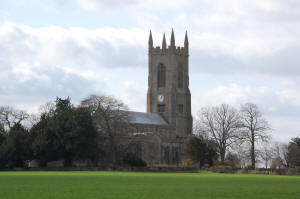
Salle Church
Norfolk has over 650 medieval churches - the highest
concentration in the world. Of these, 125 have round
towers - more than any other county in the UK. (Suffolk
has 42, Essex 7, Sussex 3, Cambridgeshire 2 and
Berkshire 2.)
Norfolk's churches vary from the spectacularly grand
- such as Walpole St Peter and Salle - to the tiny, remote
round-towered versions - such as Bessingham, Hales or
Framingham
Earl. Along the North Norfolk coast at
Blakeney,
Cley and Cromer the
churches are large - reflecting the wealth of these
earlier prosperous ports. Cromer has the tallest tower
in the county at 160 feet. Then there are the thatched churches like Thurne
and Mautby, the ruined ones like at Shotesham and Great
Hautbois, the tower-less ones like
Thurgarton and
Mundesley, the positively
bizarre ones like Burgh St Peter and the
'two-for-the-price-of-one' churches such as Reepham and
South Walsham.
John Betjeman's love of churches began, we are told,
by seeing the outline of St. Peter's Church at
Belaugh from his father's boat on the
River Bure. Many years later he returned to the site
for one of his popular BBC programmes A Passion for
Churches.
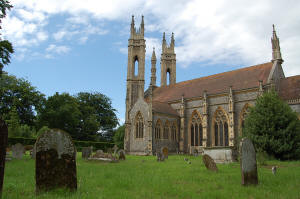
Booton Church
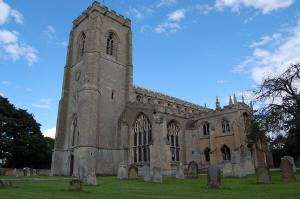
Walpole St. Peter
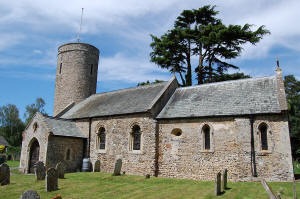
St. Andrew's, Framingham Earl (with round tower) Most of Norfolk's churches are made from
flint and this may explain the high number of round
towers - as these do not require stone quoins. Norfolk's
only other workable stone is carrstone which is
sometimes used as a building material in north and
north-west Norfolk. Bessingham church tower, for
example, is partly composed of carrstone - or
gingerbread stone as it is known locally. The Normans
introduced stone which was imported from as far
afield as Caen in Normandy. This was used on some of the
grander churches in the county such as Wymondham Abbey,
St Margaret's at King's Lynn or Cawston tower. The
stone for Norwich Cathedral was brought from Normandy
and transported by boat up the
River Yare and then
a further half-mile along a canal from
Pulls Ferry to the construction site. Church
crawling in Norfolk is one of the best ways to discover
the county's hidden gems - particularly if you do it on
foot or by
bike. The
Norfolk Churches Trust and
the Churches
Conservation Trust do their best
to keep as many of the county's redundant churches open as
possible.
|
Norwich Churches
Norwich has 36 medieval parish churches: St Andrew, St
Augustine, St Benedict, St Clement, St Edmund Fishergate,
St Etheldreda, St George Tombland, St George Colegate,
St Giles, St Gregory, St Helen, St James Pockthorpe, St
John Maddermarket, St John de Sepulchre, St John Timber
Hill, St Julian, St Lawrence, St Margaret, St Martin at
Oak, St Martin at Palace Plain, St Mary Coslany, St Mary
the Less, St Michael at Plea, St Miles Coslany, St Peter
Hungate, St Peter Mancroft, St Peter Parmentergate, St
Saviour, St Simon and St Jude, St Stephen, St Swithin
and two cathedrals (1 Anglican and 1 Roman Catholic).
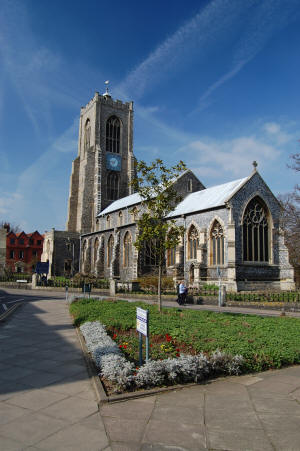
St. Giles on the Hill,
Norwich
The fact that most of these churches survive today is due,
in large part, to the work of Wilhelmine 'Billa' Harrod
(see also Letheringsett). In 1970, 32 of these
churches were facing demolition but Billa, a devout
Anglican and conservationist, decided to take action. With the support of John Betjeman,
the poet laureate, she founded the Norfolk Society Committee for Country Churches - which
later evolved into the Norfolk Churches Trust.
Thankfully, most of Norwich's churches were preserved.
Most are no longer used for services
but the buildings are utilised for other
community projects including: Norwich Arts Centre (St Swithin),
art galleries, puppet theatre (St. James Pockthorpe), martial
arts, book stores, antiques (St Michael at Plea) and
previously night-shelters (St.
Martin's on Oak Street). These churches are a familiar
part of Norwich and should be preserved for posterity.
|
| Top Ten Literary Churches in Norfolk 1) St. Nicholas
Dereham - William Cowper is buried here.
There is a magnificent stained glass window dedicated to
him and also a monument by Flaxman.
2) St Mary's Ditchingham - Henry Rider Haggard is
buried in the chancel and there is a commemorative
stained glass window. His daughter Lilias Rider Haggard
(also a writer) is buried in the churchyard.
3) St. Peter Mancroft, Norwich -
Sir Thomas Browne is
buried here.
4) St Andrew's, Framingham Earl - W.G. Sebald is
buried here.
5) St. Mary's, Itteringham - George Barker the poet is
buried here.
6) St. Peter's, Shropham - the novelist and short story writer
Mary Mann is buried here.
7) St. Nicholas Chapel, King's Lynn - various
Robinson Crusos (without an 'e') are buried here. The name may have
influenced Daniel Defoe.
8) St Stephen's, Potter Heigham - the Norfolk
humorist Sidney Grapes was a church warden here and
there is a commemorative oak-panelled clergy vestry
dedicated to him.
9) St. Peter and St. Paul, Mautby - Margaret Paston, who wrote many of the
Paston Letters, is buried here.
10) St Peter's, Belaugh - this was the first
church that Sir
John Betjeman ever fell in love with.
|
Links:
More Norfolk Church Photographs
More Norwich Church Photographs
More Round Tower Church Photographs
|
|

